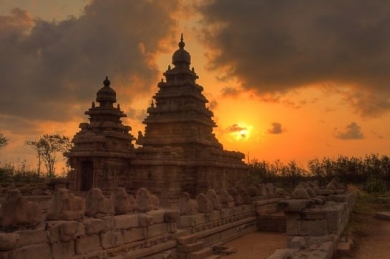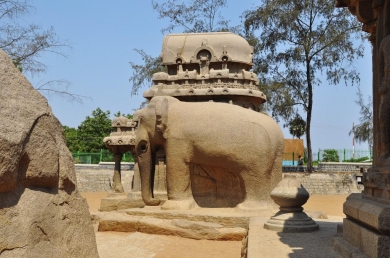The heritage city of Mamallapuram, the 7th century seaport of the Pallava Empire. Mamallapuram draws thousands of tourists every year, who come here to see it's lovely beaches and fascinating temples and architecture. Mamallapuram is the birthplace of temples, the crucible of Hindu religious architecture in the south. The style first initiated in this heritage city was redefined and refined till it reached its zenith in Madurai’s Meenakshi Temple and Thanjavur’s Brihadeeshwera. Mamallapuram or Mahabalipuram has to be experienced for its beautiful beaches, 14 rocktemples, 9 monolithic shrines, 3 stone temples including the exquisite Shore Temple and 4 sculpted bas reliefs defy description.
The archetype of Dravidian temples, the inspiration and the cornerstone of all others belonging to the genre can be found at Mamallapuram. This was the first time ever that builders used features that would become integral elements of every temple, not just in the south but also elsewhere in India. The craftsmen who built the rock temples pioneered the use of vimanas, gopurams, mandapams and the intricate carving that make them works of art.
The monumental works of art at Mamallapuram use nature’s bounty as their canvas, monolithic rocks, hills, blocks of stone, cliffs and caves were all put to good use by the builders. Rocks were fashioned into rathas, temples scooped out of hills and boulders chiselled into blocks and pillars for mandapams. Take the fabulous bas-reliefs, they use sheer cliff faces as their canvas, engraving upon them complete legends and stories.
Some important questions arise when we choose a destination.
Most important places to Visit in Mahabalipuram or Mamallapuram . / Sightseeing places in Mahabalipuram or Mamallapuram.
Which all places I can visit along with Mahabalipuram or Mamallapuram ?
Tour Itineraries along with Mahabalipuram or Mamallapuram
Best time to visit Mahabalipuram or Mamallapuram
How to reach Mahabalipuram or Mamallapuram?
Sightseeing places in Mahabalipuram or Mamallapuram
The sightseeing options in Mamallapuram run from temples, shrines and wonderful sights of rocks precariously balanced.
The Shore Temple at Mamallapuram was constructed in the 7th century, during the rule of the Pallava king Narasimhavarman II Rajasimha. A structural temple, it is crafted from stone and put together by master masons who assembled it block by block. In this, it differs from others at Mamallapuram that were carved out of pure rock. The temple is a masterly example of the Pallava style, but was built so close to the shoreline that the waters of the Bay of Bengal have eroded its outer boundaries.
Three shrines combine to make up the Shore Temple – two dedicated to Shiva and one to Vishnu. The vimana over the Vishnu shrine has eroded with time but happily, the other two are intact. The Shiva shrine is adorned with reliefs, to the left of the Shore Temple stands the Dhvajastambha, a stone pillar visible even from ships far out at sea. The walls surrounding the temple were decorated with charming figurines of Nandi, Shiva’s faithful bull, sadly, only a few remain but they are enough to indicate how glorious the temple must have looked in its hey day.
The best preserved of the rock temples are collectively known as the ‘five rathas’ named for members of the Pandava clan from the epic Mahabharata. Why they are called ‘ratha’ (chariot) remains a mystery, for they bear no resemblance to any vehicle!
Carved from huge rock monoliths, the raths incorporate different elements – the biggest one, multi tiered with a domical shikhara is the Dharamraja Ratha (he was the eldest Pandava sibling). A smaller version of the Dharamraja ratha is named Arjuna , after the heroic warrior of the Mahabharata. These two rathas are embellished with sculptures of kings and couples, possibly members of the royal family. The ratha with a barrel shaped vault represents the Pandava strongman, the mighty Bhima. The Sahadeva ratha has an apsidal shape, which it shares with the imposing stone elephant that stands in front of it. Draupadi, the wife of the Pandava brothers gets her own ‘hut’ shaped ratha preceded by a stone lion, representing the goddess Durga.
One of the most brilliant sights is Arjuna’s Penance , 29m by 13m, carved in relief on the face of a huge cliff. It features Arjuna, the heroic warrior of the Mahabharata who had qualms about the fratricidal battle he was due to fight. The southern face of the cliff tells the story of Arjuna’s penance on the banks of the River Ganga where he prayed to Lord Shiva for the boon of ‘Pashupatashastra’, Shiva’s favourite weapon endowed with magical powers. The scene portrayed on the rock face shows an ascetic standing on one foot performing penance, seated nearby are Lord Shiva and his entourage. A natural fissure in the rock is cleverly used to render the River Ganga; some say that once water flowed down the crevice adding another dimension to the creation. Detailed carvings of gods and goddesses, snakes, birds, animals, creepers and trees complete the representation.
The artist or artists turned to fables from the Panchatantra for inspiration and ideas for the opposite side of the cliff. The fables, like Aesop’s use animals to impart moral lessons to the viewer – an all time favourite is the story of the deceitful cat who successfully fools a group of mice with its fake piety! The realistic depiction of elephants, cats, lions, boars and tigers has universal appeal and is certainly a clever way to teach a lesson!
Excavated from the rocky hillside are two beautiful rock temples, the Mahishamardani and the Adivaraha Mandapas. The temples have exquisitely beautiful sculpting, considered by experts to be the most outstanding reliefs in India. Dedicated to Durga Mahishasurmardani, slayer of the demon Mahishasura, the Mahishamardani Temple is cut into the rock on the eastern side of the hill near the lighthouse. The three shrines within the temple have ornate sculptural reliefs, one depicting Durga battling the demon and one of Lord Vishnu in cosmic slumber on the coils of the serpent king, Seshnaga. The artist successfully captures both the intense energy of a battle between the forces of good and evil and the contrasting serenity of a god in repose.
The Adivaraha Temple contains beautiful group sculptures, deities and sub divinities. Outstanding amongst all of them are two group sculptures that portray a king flanked by his two queens, one seated and one standing. The seated king is identified as King Simhavishnu (574-600AD) while the standing king is his son and successor Mahendra I (600-630AD.
Walk down to the old lighthouse on the way to Krishna’s Butterball , a huge rock that is precariously balanced on its tip on a sloping rock face. 5 km off are the carved Tiger Caves , which used to be an ancient open-air theatre.
Which all places I can visit along with Mahabalipuram or Mamallapuram ?
Tour Itineraries along with Mahabalipuram or Mamallapuram
Chennai - Kanchipuram - Mahabalipuram - Chennai
Chennai - Kanchipuram - Mamallapooram - Tiruvannamalai - Pondicherry
Chennai - Kanchipuram - Mahabalipuram - Pondicherry - Sawamimalai - Tanjore
Chennai – Kanchipuram – Mahabalipuram – Pondicherry – Trichy - Madurai
Tanjore - Madurai - Kodaikanal - Munnar - Cochin - Mararikulam - Chennai
Chennai – Kanchipuram - Mahabalipuram - Pondicherry - Thanjavur - Trichy - Madurai - Rameshwaram - Madurai - Chennai
Hyderabad - Warangal - Vijayawada - NagarjunaSagar - Srisailam - Kurnool - Puttaparthy (Puttaparthi) - Tirupati - Chennai
Pune/Mumbai- Rajkot-Somnath-Dwarka-Jamnagar-Ahemdabad-Ujjain-Omkareshar-Delhi- Varanasi-Haridwar-Rudraprayag - Kedarnath-Rishikesh-Nashik-Aurangabad-ParliVaidyanath- Hyderabad- SrisailamMallikarjun-Chennai-Madurai-Rameshwaram – Madurai
Best time to visit Mahabalipuram or Mamallapuram
The best time to visit Mamallapuram, also called Mahabalipuram is from October to March, when the climate is pleasant and ideal for sightseeing, outings and adventure activities, as the temperature varies between 16°C and 30°C. All throughout the year, this place experiences moderate and humid climate.
During the summer season, from March to May, it is extremely hot with temperature varying a minimum of 21°C to a maximum of 42°C and hence it is best to avoid visiting Mamallapuram in summer months.
How to reach Mahabalipuram or Mamallapuram?
How to Reach Mamallapuram by Air
The closest airport to Mamallapuram is at Chennai, which is 58km away. Chennai is well connected to the rest of India and has it's own international airport as well. From the airport you can hire a cab to get to the small town of Mamallapuram.
How to Reach Mamallapuram by Rail
The nearest railway station is at Chengalpattu 29 kms away. The Chengalpattu station is well connected to Chennai and other parts of Tamil Nadu. From here you can take a bus or taxi to get to Mamallapuram.
How to Reach Mamallapuram by Bus
Mamallapuram or Mahabalipuram is well connected with the rest of the state. Buses from Chennai, Pondicherry and Chengalpattu and Kanchipuram are frequent. Most tourists prefer to travel to Mamallapuram by road from Chennai.
Packages

4 Nights Tamil Nadu - 3 Star - Rs.26100
Mahabalipuram Packages

5 Nights Tamil Nadu - 3 Star - Rs.30200
Mahabalipuram Packages

5 Nights Tamil Nadu - 3 Star - Rs.27400
Mahabalipuram Packages
